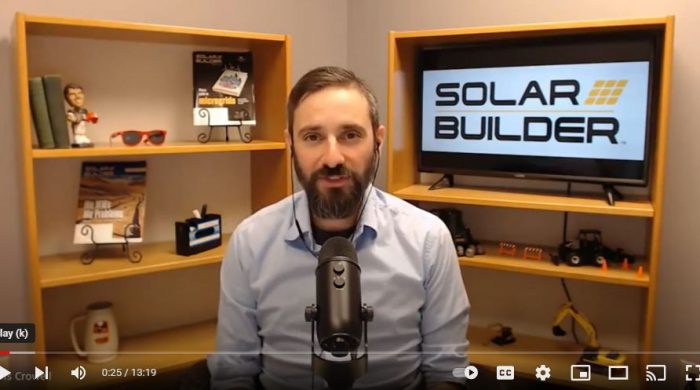State of the solar job market (and where to focus your resources)


We are extending The Buzz online! In this new video discussion series on our YouTube channel, we will give our two cents per kWh on residential and commercial solar storylines. In episode 1, Jeremy Belej, strategic success manager at Aurora Solar, joins to discuss …
- 0:38 – What are solar installers saying about the labor market?
- 1:06 – Does solar have an advantage over other skilled trades?
- 2:10 – Where do solar installers need the most help?
- 2:41 – Why to focus on the sales department
- 4:14 – Pitfalls when onboarding and training sales personnel
- 6:36 – In-home vs. virtual sales and remote vs. in-office positions
- 7:31 – Examples of cross-training departments
- 8:32 – Doing away with departmental inefficiencies
- 10:24 – Tips for starting up a solar business in lower demand areas
- 11:43 – Providing “careers” instead of “jobs”
- 13:02 – What’s the ONE department solar installers should invest more resources in right now.
Be sure to watch the full 14 min chat right here. You can also skim part of the conversation below:
Crowell: Skilled trades are in a rough patch in terms of finding enough workers. What are you hearing from your installer customers right now about the labor market?
Belej: We’ve heard that the demand for solar installations keeps growing, and a lot of folks are challenged to keep pace with that. There are projects and willing customers, but timelines for installations sometimes get longer because there’s just too much work to be done.
Crowell: It seems to me, going forward, that solar might have a leg up gaining workers over traditional skilled trades because it is maybe a cooler, technology-focused, future-focused industry.
Belej: To add to that, I think that as far as the education to become skilled in those traditional trades, they’re well established. Whereas with solar, [training courses] are still trying to keep up and evolve in order to make sure that demand is met, and that we have the right training and apprenticeship programs. I don’t know to what degree community colleges have solar installer programs, but once you start seeing those, I think you’ll start seeing much greater growth.
Crowell: In my mind the department that is the easiest to onboard new employees is in that sales and design area, at least in theory, because it requires software instead of ladders and lag bolts. But maybe that’s just me because I’m a soft, sweater-wearing type of guy.
Belej: At Aurora, we would agree. Sales are such a growing part of the industry because you need those sales in order to have projects be installed, and it is super easy for folks to get on board with the software that makes it a little bit easier. Then, it’s a matter of finding the prospects who are motivated and getting them to commit. That can be challenging to navigate correctly.
Obviously, integrity is a big piece in making sure that folks sell on the correct things and sell a solution that works for the home. Our software helps to do that, but I think that part of the business is maturing and getting a little bit more standardized.
Crowell: Definitely. While it might be the easier path to getting a new employee in the door, through the sales and design side, a lot of things can go wrong there, right? The accuracy of that proposal and that sales pitch is crucial. What are keys to training personnel on the sales and design side?
Belej: With any software, there’s usually a learning curve, and the key is to take the time to make sure that the employees and the sales reps who are going to be interacting with your sales workflow understand it from tip to tail. Explaining the ‘why?’ is important. Folks can skip over that, and then it’s just trying to get to as many sales meetings as possible. Truly where we see the folks who benefit the most and who are able to do this for a long period of time are understanding the why and how to speak to homeowners in a way to build confidence, and you can do that through accurate tools that can show you why a particular array is designed in a certain way.
Crowell: Sometimes the labor issue can just be a company issue, I feel. What are some departmental or workflow inefficiencies that can lead to a contractor wasting labor hours that could be better spent elsewhere?
Belej: In the customer life cycle or in the sales journey, there are areas where you can improve. Qualifying leads better is a key thing. Once somebody puts their hand up saying, ‘Hey, I am interested in learning what solar might do for my home,’ and getting a consultation to review those designs — the more you shorten that, the better.
And then one of the big things you’ll hear in solar is reducing change orders. That is a huge key to making sure that a project is ultimately installed and the customers are happy. The more you can reduce those hopefully down to zero, the better experience it is for the customer, the quicker it is from a sale to an install, and really, at the end of the day, the likelihood that it’s actually going to be installed on the roof and connected to the power grid.
Pick up the conversation right where we left off!
Listen to more in-depth conversations on Solar Builder’s YouTube channel
Our most popular series include:
Power Forward! | A collaboration with BayWa r.e. to discuss higher level industry topics.
The Pitch | Discussions with solar manufacturers about their new technology and ideas.
Source link






